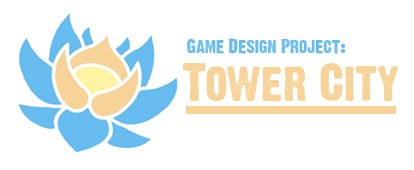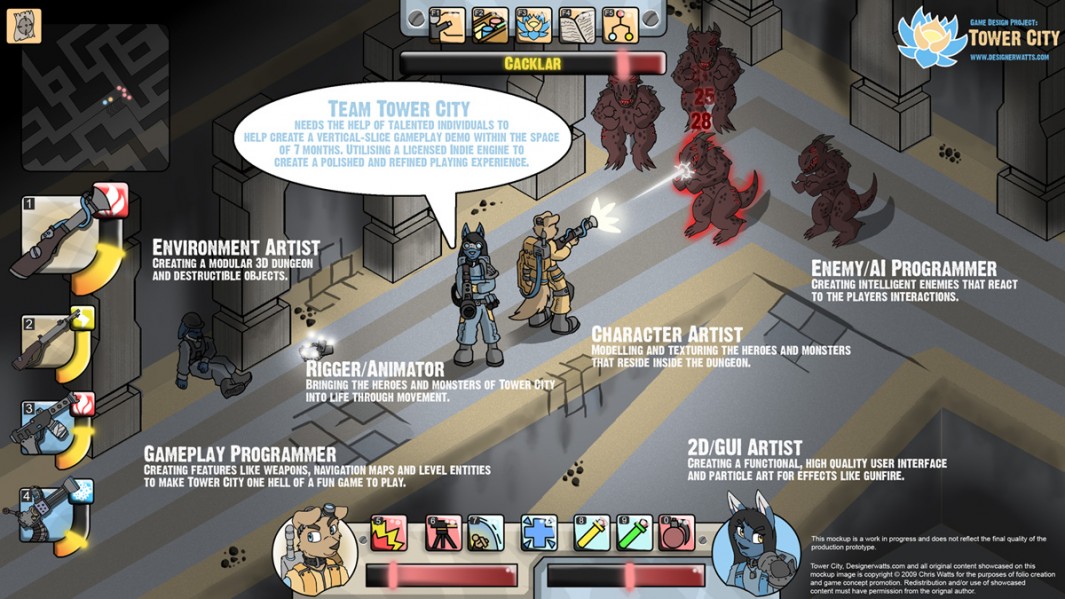If you don't yet know about the game design project Tower City. Please check
out the following link before proceeding: http://www.tsumea.com/journal/designerwatts/240309/tower-city-video-log…
Greetings. :)
I present to you kind people a proposal. Seeing just how large and willing the
indie scene is at the moment and with the projects currently in circulation
I would like to put forward a plan for creating a playable prototype alongside
the game design document development for Tower City.
If this proposal doesn’t take off. The design document and video logs
will continue regardless. My aim with this prototype is to not only give prospective
greenlight funders a tangible example of the design proposed. But also provide
the indie community with an interesting project to participate in.
As I’m currently living off saved funds and plan to until my game design
folio is complete my dedication to Tower City is more then full time. Spending
up to 45 hours a week working on design documentation and video log presentations.
People interested in this project can rest assured that the designer will be
supporting them 100% of the way.
Please read the small proposal below. And if you’re interested in working
on this project please send me an e-mail at designerwatts@hotmail.com with the
following:
- Your name
- What your skills are and any accreditations. [Previous work, folios, education.]
- What you would like to do for this project.
- How much time per week can you dedicate to the project.
- Anything else you’d like to add. :)
As for people I can put to work right now I need a responsible and dedicated
programmer to become the programming lead. I would get him to start researching
into the game engines. And a 2D concept artist is someone I need to put a real
artists vision into the world of Tower City.
Cheers! :)
Tower City – Prototype Proposal.
Goals:
To create a fully refined and working prototype that demonstrates the core
gameplay principles behind the design of Tower City.
The Prototype will represent a “vertical slice”
of the game and fulfill the following features in a playable demonstration:
- 1 level/floor of the tower dungeon. – Playable from entry to exit
gate.- The level must contain an objective that the player needs to fulfill
to progress to the next floor.
- The level must contain an objective that the player needs to fulfill
- Player characters - The two main characters along with a basic demonstration
of their unique abilities and skill sets. - Weapons – 4 weapon types that all give a different way to approach
combat. - Inventory and equipment – The inventory and character equipment feature
must be demonstrable. - Enemies – 5 enemy types showcasing different basic AI behaviors.
- End product is a PC demo that can be installed and played on it’s
own.
What is a “vertical slice”?
A vertical slice in the game development industry refers to making a demo that
demonstrates what a fully produced final product of the game would look and play like.
Only it's focused on a small slice of the game, the demos running time being around
5-20 minutes of play. For games of a moderate to large production scale, creating
a polished vertical slice that’s fully playable is one of the best ways
to approach green lighting for a new IP.
Prototype proposal:
With the focus of the prototype being a demonstration of the game play concepts
described in the game design document being created at the same time. Tower
City will use a pre-existing engine that can be scripted and modified to suit
the needs of the project in order to focus programmer efforts towards implementing
gameplay-based features. This engine will be ether be an indie licensing of
Unity 2.5 or TGEA. Chris Watts will initially provide the funding to buy the
indie licenses.
The production of this prototype will go hand in hand with the production of
the game design document. The production plan is broken into time based 3 stages,
which are further broken up into milestones. This outline is as follows:
Production plan outline:
Project Start – 1st Apirl 2009
Project End – 1st November 2009
Stage 1 – Pre-production
1st April to 30th April
The pre-production stage of the prototype will be fronted by a lead programmer
and a 2D concept artist.
- The Lead Programmer will be tasked to download and trial the two engines
Unity 2.5 and TGEA [Torque game engine advanced.] He will research and evaluate
the two products and present the funder [Chris Watts] with which one will
give the most benefit to the type of game desired to be prototyped.
- The 2D concept artist will begin work on illustrating the world of Tower
City and create a consistent artistic continuity for 3D artists to reference
in the production stage.
Once the engine has been decided upon. The project will kick into production.
Stage 2 – Production
1 May to 31st of August
The production stage of the prototype will have a team of two-four programmers,
one concept artist, one GUI artist, two 3D artists and one rigger/animator.
These people will be needed at different times of the production stage. Programmers
and Artists will have a lead they report progress and problems to. Leads will
report to Chris Watts. [This list is a current estimate and is subject to change.]
The production stage consists of:
- Programmers - Coding and implementing features like:
- Player control
- Weapons
- Player character skills and abilities
- Camera parameters
- Enemies and their AI
- Level entities [start and exit gates, random monster drops etc.]
- Inventory/Equipment screens and their usability.
- Artists - Creating and implementing in game artwork for:
- The two main characters. [Requires animation support.]
- Weapons and weapon effects.
- Game User Interface design and Art.
- Enemies. [Requires animation support.]
- Environment Art.
- Dungeon rooms and corridors.
- Nick-knacks to populate the rooms.
As we move into the production stage a more detailed outline of what will be
needed will be provided.
If artistic requirements cannot be meet then the prototype will opt to be presented
in a clean gray-box style representation. Coding requirements must be met however.
They cannot be downscaled.
Stage 3 – Polish
1st September to 31st October
The stage of the prototype will give the developers of the project 2 months
to polish and refine the prototype from all facets. From September onwards no
new code features are to be added and all art assets must have a placeholder
gray-box implemented.
Demo release:
1st of November
To coincide with the final video log of the game design folio which ends with
presenting a full production plan, the prototype demo will be released along side
it. This will give prospective greenlight funders not only a full game design
document backed up with video logs. But a Vertical Slice Demo that showcases the
game concept as a fun and engaging experience.
This vertical slice prototype is a proposal however and requires the willing
help of other indie talent to make it materialize.
What's the benefit of being on this project?
Even though the focus is on creating only 15 minutes of gameplay, the amount
of time and effort needed to create this prototype is quite large. But with
a focus on showcasing a couple of highly polished features the aim is to wow
and impress people in those 15 minutes. To claim that you worked on a game demo
to that level of quality would shine very kindly upon your folio whether you
coded, modeled or animated.
The focus here is quality over quantity.
Cheers!
Chris Watts
- Log in to post comments

